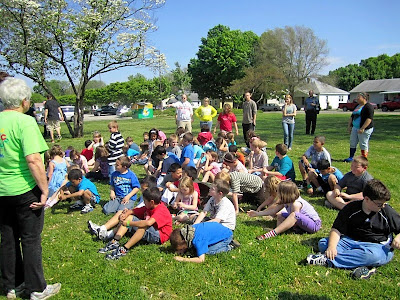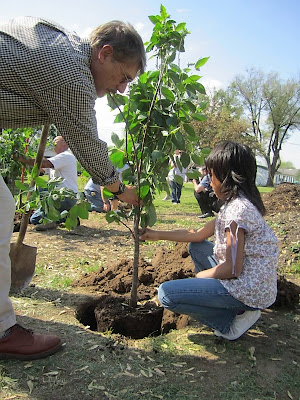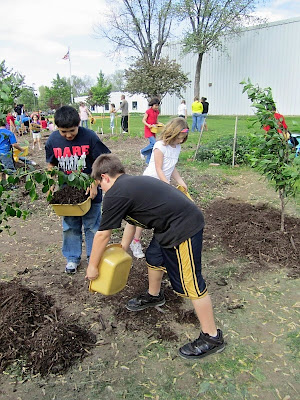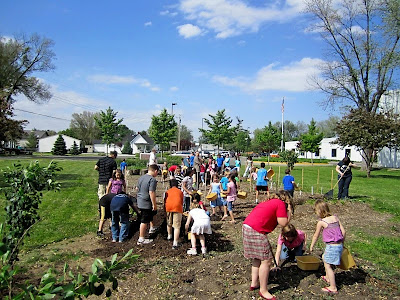Schedule
7:30-8:30 Registration and Participant Breakfast
8:00-8:30 Welcome comments
8:30-9:30 General Session: Panel Discussion (1 CEU)
The Role of Design in Neighborhood Revitalization
Morning Sessions
9:45-10:45 Concurrent Breakout Session #1 (1 CEU)
Session 1A: Complete Streets, Indiana:
Irene Wegner, AARP Indiana
Complete streets are those designed and operated to enable safe access for all users – pedestrians, bicyclists, motorists, and public transportation users of all ages and abilities – in moving along and across roadways; they are appropriate in all communities, regardless of size or setting. The proposed session will:·highlight the benefits of complete streets, including links to health, safety, the environment, transportation network capacity, community development, and economics;· provide an overview of design elements, planning and engineering guidance, and implementation resources;· discuss the development and adoption of local, regional (MPO), and state policies for complete streets; and · engage attendees in becoming advocates for complete streets in their communities.
Speaker Biography: Irene Wegner, Associate State Director, Community Outreach Irene has worked with AARP for fourteen years, including time at the Midwest Regional Office. Before joining AARP, she worked with volunteers and community organizations by monitoring and funding over 28 agencies in the northern Chicago suburbs. She was a Director of Religious Education and taught school in various locations. Irene also helped to found WilPower, Inc., a housing and psychosocial center for persons with mental illness on Chicago’s north shore. She is an avid bicyclist and a member of Health by Design, the MPO Multi-Modal Task Force in Indianapolis, the Indiana Healthy Weight Initiative Senior Group, Crooked Creek Economic Development Corp Board member, and Bicycle Indiana. Irene holds a BS degree from Southern Illinois University and a Master of Public Administration from Roosevelt University. For the past three years her work concentration has been in the area of livable communities, primarily with mobility issues.
Session 1B: Environmental Habitat Stewardship:
Lisa Dunaway, ASLA, LEED AP, Sensible Ecology, LLC.
This session will cover some basic ecological principles that will assist landscape architects in making better design decisions for long-term ecological and economic sustainability. Attendees will learn how to help protect biodiversity from the backyard scale to the regional scale. This session is a brief version of the Environmental Habitat Steward Certificate Program developed by Lisa in partnership with the Indiana Wildlife Federation.
Speaker Biography: Lisa Dunaway specializes in the creation and design of ecological assessments and recommendations for the preservation of ecological biodiversity and economic sustainability. She has experience with municipal comprehensive and urban design plans, parks and recreation master planning, and other projects relating to sustainability such as native landscape plantings and green infrastructure design. She also has completed numerous projects involving site sustainability planning, regional ecological planning, economic revitalization, commercial site design, downtown streetscapes, and recreation and trail planning. Lisa holds a Bachelor of Landscape Architecture degree from Ball State University and is a LEED Accredited Professional. She is currently completing a Master of Ecological Planning degree at the University of Vermont. She is also an Instructor of Urban Planning at Ball State University and the Owner of Sensible Ecology, LLC.
10:45-11:00 Vendor Expo Session
11:00-12:00 Concurrent Breakout Session #2 (1 CEU)
Session 2A: Integrating Green Infrastructure for CSO Abatement & Enhanced Public Spaces
Ms. Jean Wodarek, PE, LEED AP, Williams Creek Consulting, Inc.
Emily Kusz, RLA, LEED AP, Williams Creek Consulting, Inc.
The presentation will provide an overview of an in-depth technical and financial analysis of the potential outcomes of implementing Green Infrastructure Best Management Practices (GI BMPs) on a large scale throughout Indianapolis, Indiana. Results indicate up to 30% reduction in peak flows where GI BMPs are implemented and approximately 1.6 billion gallons per year of stormwater to be removed from the CSO system. The most cost effective GI BMPs appear to be on-lot residential rain gardens, dual use passive recreation and distributed storage bioretention systems along streets and alleys. Current pilot projects to be monitored to show the effectiveness of GI BMPs relative to the Master Plan are currently designed and ready to be built. The first two pilot projects have been public private partnerships working with the local community and business owners for increased drainage in areas with limited infrastructure while providing enhanced landscape features and public plazas. The Ohio Street Green Infrastructure/Drainage Improvement Project is a partnership effort to improve the 600-700 block of East Ohio Street. The project seeks to improve drainage, handicap accessibility, and deteriorating urban infrastructure to capitalize on recent private investment in the area as a means to continue strengthening the Cole-Noble neighborhood. The project features 1,200 square feet of pervious concrete sidewalk, 500 linear feet of pervious concrete curb and gutter and an approximately 750 square feet of rain garden. These Green Infrastructure retrofits will manage runoff from approximately 16,000 square feet of impervious surface and will infiltrate and attenuate 80% to 90% of the volume and rate, respectively, in a typical year. The Alabama Street pilot project will extend and enhance an existing boulevard median into a 2,500 square foot pedestrian plaza made of porous concrete, pavers, and rain gardens. Retrofits to the road alongside the median will include the integration of four bumpout rain gardens, each approximately 240 square feet. The pedestrian plaza and rain gardens will manage approximately 3 acres of runoff, or about 1 acre of impervious surface. It will infiltrate and attenuate 80% to 90% of the runoff volume and rate, respectively, in a typical year. More specifically, the project will address how landscape architects can address issues such as stormwater management in both traditional landscape improvement projects and public spaces such as plazas.
Speaker Biography :Ms. Jean Wodarek, PE, LEED AP is currently a Senior Project Manager at Williams Creek Consulting in Indianapolis. She has been involved with the planning and design of a wide range of Civil Engineering projects for over 21 years. Her background includes surveying, construction inspection, site evaluation and master planning, storm water management, and all aspects of public and private utility and infrastructure design, sustainable sites and Green Infrastructure master planning and design, project management, and quality assurance review. Her most recent projects include the City of Indianapolis Green Infrastructure Master Implementation Plan, the City of Lafayette Green Infrastructure Feasibility and Prioritization Study, the City of Columbus Ohio Reservoir Pollution Reduction Project, the LaPorte Joint Zoning Ordinance, and numerous private development projects incorporating green infrastructure. She holds a Bachelor of Science in Civil Engineering from Michigan Technological University and is a registered Professional Engineer in Michigan, Indiana, and Ohio.
Ms. Emily Kusz, RLA, LEED AP has gained extensive experience in landscape design, while participating in over five years of commercial and residential civil engineering layout and plan development. Her diverse work experience ranging from direct client interaction, to land plan and landscape design, to plan development conducting her own drainage and grading calculations in AutoCAD have provided her with a diverse background and unique abilities directly related to low impact site design. With her unique professional experience combined with her education, Ms. Kusz has developed a deep understanding and commitment to sustainable site development. Ms. Kusz holds a bachelor of Landscape Architecture from Ball State University with a minor in Natural Resources and Environmental Management.
Session 2B: Branding & Positioning Secrets for a Down Economy:
Josh Miles, Miles Design
Uncover the secrets to growing your business by narrowing your focus. We'll discuss the power of niche positioning using the "wedge" model, and how to market within that niche to appeal to the broadest number of people. We'll look at a framework to help you envision your expert firm, building upon your marketing assets, discovering which branding and marketing assets you need to develop next (branding, positioning, interactive, social media, print, and networking), and explore a roadmap for which marketing tactics to pursue first. Finally, we'll delve into the pivotal role that thought leadership plays in demonstrating your unique positioning, especially in a downturn. This will be a very interactive session - plan to leave with handouts and roadmaps for uniquely positioning your firm!
Speaker Biography: Josh Miles is principal of Miles Design, an award-winning Indianapolis branding and design firm. Miles Design specializes in positioning, branding and interactive design for premium brands and professional services firms. Their client list includes Ratio Architects, Bose McKinney & Evans, Chalet, ExactTarget, AIT Laboratories, and KITE.
As a substitute to the morning’s indoor sessions, participants may choose:
9:45-11:45 Walking Tour # 1 (2 CEU)
Join Leaders from Southeast Neighborhood Development Corp. on a walking tour of the Fountain Square Neighborhood.
12:00-12:30 Vendor Expo Session
12:30-2:30 Lunch and INASLA Awards Presentation
Luncheon Speaker (1 CEU): Gary Scott, ASLA, Immediate Past President
Awards Presentation (.5 CEU)
Afternoon Sessions
2:30-3:00 Vendor Expo Session
3:00-4:00 Concurrent Breakout Session #3 (1 CEU)
Session 3A: St. Clair Place: Streetscape and Neighborhood Revitalization:
Jonathan Mooney, ASLA, RLA, LEED AP, R.W. Armstrong



 David is a Licensed Landscape Architect in the States of Indiana and Illinois and has been recognized with a variety of awards and honors from a variety of organizations :
David is a Licensed Landscape Architect in the States of Indiana and Illinois and has been recognized with a variety of awards and honors from a variety of organizations :









 On April 30th INASLA assisted the Columbus Parks and Recreation Department in their Arbor Day Tree Planting Ceremony at the Foundation for Youth (FFY). Over 30 children spent time learning about the benefits of trees as well as the profession of landscape architecture. Three cherry trees were planted adjacent to the FFY Garden that supplies a variety of vegetables and flowers to the children throughout the summer. The cherry trees will add to the variety offered. The children tend to the garden throughout the summer with the season culminating with the sale of homeade salsa from the garden produce. The garden and tree planting are wonderful examples of positive ways to encourage children to spend time outdoors! Each child was given a small tree sponsored by ASLA to plant in their yard when they return home.
On April 30th INASLA assisted the Columbus Parks and Recreation Department in their Arbor Day Tree Planting Ceremony at the Foundation for Youth (FFY). Over 30 children spent time learning about the benefits of trees as well as the profession of landscape architecture. Three cherry trees were planted adjacent to the FFY Garden that supplies a variety of vegetables and flowers to the children throughout the summer. The cherry trees will add to the variety offered. The children tend to the garden throughout the summer with the season culminating with the sale of homeade salsa from the garden produce. The garden and tree planting are wonderful examples of positive ways to encourage children to spend time outdoors! Each child was given a small tree sponsored by ASLA to plant in their yard when they return home.





